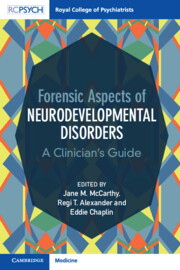Book contents
- Forensic Aspects of Neurodevelopmental Disorders
- Forensic Aspects of Neurodevelopmental Disorders
- Copyright page
- About the Cover Page
- Contents
- Contributors
- Foreword by the Rt Hon Lord Bradley
- Terminology Used in the Book
- Section 1 An Overview: Definitions, Epidemiology and Policy Issues
- Section 2 Assessment and Therapeutic Approach
- Section 3 Criminal Justice Pathways and Legal Issues
- Index
- References
Section 1 - An Overview: Definitions, Epidemiology and Policy Issues
Published online by Cambridge University Press: 18 May 2023
- Forensic Aspects of Neurodevelopmental Disorders
- Forensic Aspects of Neurodevelopmental Disorders
- Copyright page
- About the Cover Page
- Contents
- Contributors
- Foreword by the Rt Hon Lord Bradley
- Terminology Used in the Book
- Section 1 An Overview: Definitions, Epidemiology and Policy Issues
- Section 2 Assessment and Therapeutic Approach
- Section 3 Criminal Justice Pathways and Legal Issues
- Index
- References
Information
- Type
- Chapter
- Information
- Forensic Aspects of Neurodevelopmental DisordersA Clinician's Guide, pp. 1 - 124Publisher: Cambridge University PressPrint publication year: 2023
